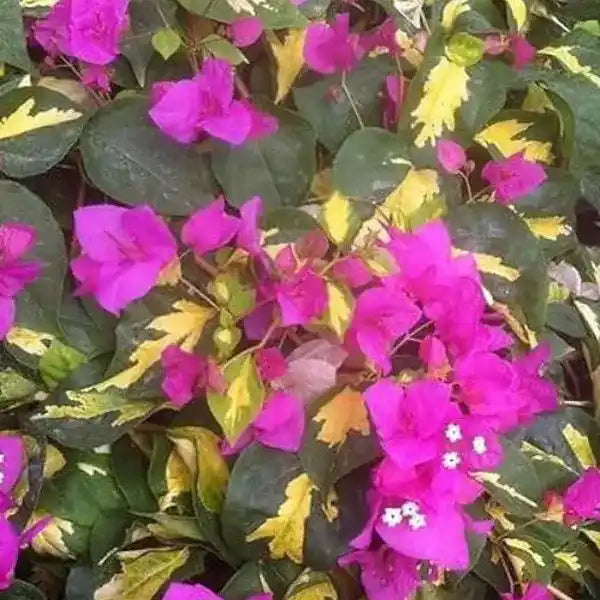Bougainvillea Thima
- Rs. 149.00
-
Regular price
Rs. 299.00 -
-50%
- Will be in stock after
Vendor: Jiffy Plants
Couldn't load pickup availability
Spend Rs 1499 for free shipping
Guarantee safe checkout


Bougainvillea Thima
Selling Size : Secure Packing
Bougainvillea, with its vibrant, paper-like bracts (often mistaken for flowers), is a beloved plant in India due to its ability to thrive in warm climates and its relatively low maintenance once established.
Here's a comprehensive guide care for Bougainvillea:
1. Sunlight:
Full sun is paramount for abundant blooms. Bougainvillea needs at least 6 hours of direct sunlight daily. The more sun it gets, the more flowers you'll see.
In insufficient light, it will produce more leaves and fewer flowers.
2. Soil:
Well-draining soil is crucial. Bougainvillea is very susceptible to root rot in waterlogged conditions.
It prefers sandy or loamy soil with a neutral to slightly acidic pH (5.5-6.5).
If growing in pots, use a potting mix designed for palms or cacti, or create your own by mixing garden soil, sand, and a small amount of compost. Avoid mixes with a lot of peat moss, as it retains too much moisture.
Ensure pots have adequate drainage holes. You can add crushed bricks or gravel at the base for better drainage.
3. Watering:
Bougainvillea loves it dry once established. Overwatering is a common cause of poor flowering and root rot.
During establishment (first 1-2 years): Water regularly to keep the soil moist but not waterlogged. Water deeply once or twice a week, depending on temperature and humidity.
Once established: Reduce watering significantly. It thrives on infrequent, deep waterings rather than frequent shallow ones.
Summer (April-June in India): Water daily if in a pot or full afternoon sun. Early morning watering is best. Let the top 1-2 inches of soil dry slightly between waterings.
Winter (December-February in India): Water every 10-14 days, or when the soil feels completely dry.
Monsoon: Skip watering during frequent rains. Ensure pots have excellent drainage.
A common saying for bougainvillea is "stress equals more flowers." Allowing the plant to dry out slightly between waterings encourages blooming.
4. Fertilization:
Bougainvillea needs regular feeding during its active growing season (spring and summer) to promote blooms.
Use a phosphorus-rich, low-nitrogen fertilizer. Nitrogen promotes leafy growth at the expense of flowers.
For potted plants: Fertilize every 2-6 weeks during the blooming season. Some sources suggest a water-soluble plant food mixed at half strength every two weeks.
For in-ground plants: Fertilize every 4-6 weeks. You can use organic options like bone meal or banana peel compost. Avoid overly rich soil with high organic content, as it promotes foliage over flowers.
Reduce or stop fertilizing during fall and winter.
5. Pruning and Training:
Regular pruning is essential for a bushy plant with abundant blooms. Bougainvillea blooms on new growth, so pruning stimulates more flowers.
Timing:
Heavy pruning: Late winter or early spring before new growth begins. This helps shape the plant and encourages a flush of new growth and blooms.
After each bloom cycle: Trim long, weak stems to maintain shape and stimulate fresh growth for the next bloom cycle. Pinch off faded blooms to encourage new ones.
Throughout the growing season: Trim tips of branches to encourage new branching and a denser display of bracts.
Technique:
Cut just above a leaf node to encourage new growth from that point.
Remove any dead, diseased, or crossing branches.
Wear gloves when pruning as the plant has thorns.
Training: Bougainvillea is a climbing vine and needs support. Train it on trellises, arbors, fences, or walls. You'll need to tie them up as they don't have tendrils. Shorter, shrubby varieties can be trimmed into hedges or topiaries, and can even be grown as bonsai.
6. Temperature and Climate (India Specific):
Bougainvillea thrives in hot, dry summers and can withstand mild winters.
In tropical and coastal areas of India, it can bloom almost year-round.
In colder regions (like North India), protect it from frost by shifting pots indoors or using winter covers if temperatures drop below 4°C (40°F).
7. Pests and Diseases:
Bougainvillea is generally quite hardy, but keep an eye out for:
Pests: Aphids, mealybugs, spider mites, leaf miners, caterpillars (like the bougainvillea looper), and scale insects. Treat with insecticidal soap, neem oil, or appropriate pesticides if infestations are severe.
Diseases: Root rot (due to overwatering), bacterial and fungal leaf spots, and black mold (often a result of honeydew from pests). Ensure good drainage and air circulation to prevent fungal issues. Remove infected parts promptly.
Leaf drop can be a symptom of overwatering, underwatering, low light, or cold temperatures.
Poor flowering is often due to overwatering or lack of sunlight.
8. Repotting (for potted plants):
Repot every 1-2 years, ideally in spring or early summer.
Bougainvillea actually blooms better when slightly root-bound, so don't choose a pot that is too large.
Handle the root ball with care, as its roots are thin and easily damaged.
By following these care guidelines, your bougainvillea will flourish and provide a spectacular display of vibrant color in your Indian garden!
